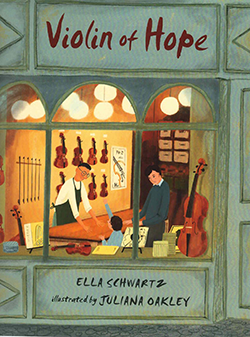Violin of Hope by Ella Schwartz with illustrations by Juliana Oakley; Minneapolis, Minnesota: Kar-Ben Publishing © 2024; ISBN 9798765-604199; 32 pages, $19.99

 SAN DIEGO – Before the Holocaust, Papa used to play his violin to the delight of Mama and their two children, Itzik and Feiga. Sometimes he played melodies that the children could dance to, other times he played slow, sorrowful, beautiful melodies.
SAN DIEGO – Before the Holocaust, Papa used to play his violin to the delight of Mama and their two children, Itzik and Feiga. Sometimes he played melodies that the children could dance to, other times he played slow, sorrowful, beautiful melodies.
Itzik wanted to learn the violin. The first time he drew his bow across the strings, it screeched, making Feiga laugh. But Papa encouraged him, saying he would learn in time. But there would be no time.
Nazis pounded on the door and confiscated the treasured violin, throwing it onto a flatbed truck, breaking its string, and then putting it in storage in a cellar, where dust filled its body and extreme weather warped and cracked it. In the years after the Nazis’ defeat, the cellar was found, and the violin located. A luthier lovingly repaired it.
Coincidentally, the name of the boy who wanted to buy it was Isaac, a variation on the name Itzik. As his father looked on, Isaac drew his bow across the strings and the violin screeched. “Don’t worry,” said his father, “My grandfather used to play the violin … If you practice, one day you’ll play as well as he did.”
Isaac grew up to become an accomplished violinist, filling concert halls with Yiddish music.
There is an organization called Violins of Hope, which finds and restores the violins that were seized during the Holocaust. This story intended for children between the ages of 6-11 is devoid of Holocaust violence, but may lead to children asking, “Why did the soldiers take away their violin?” and thereby prompting a teaching moment for parents.
*
Donald H. Harrison is publisher and editor of San Diego Jewish World. He may be contacted via donald.harrison@sdjewishworld.com